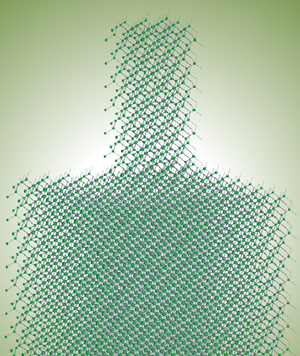Slowing Heat without Obstructions
If you want to reduce the flow of water, you would expect to narrow the pipe or maybe put obstacles into the flow. These approaches have worked for heat flow as well, but now theorists reporting in Physical Review Letters have shown how to reduce heat flow in a material by adding onto it, rather than blocking the flow directly. Their computer simulations show that heat flow along a thin film of silicon can be drastically reduced by erecting nanoscale pillars on top of it. Atomic vibrations in the pillars end up slowing the main flow through the film. The team says that the pillars should reduce heat transport without impeding the flow of electric current—a combination that is critical to thermoelectric devices, which are used for refrigeration and for generating electricity.
Thermoelectric materials are used in two important types of devices: those that electrically manipulate heat, such as coolers for electronics, and those that transform heat into electricity, such as generators on satellites. Good thermoelectric performance requires a low thermal conductivity to maintain some isolation between the hot and cold sides of a device. Researchers have tried various schemes to reduce heat transport, such as putting holes or inclusions of other materials into a thermoelectric material, but these tend to reduce the flow of electric current as well, which negates the improvement.
Mahmoud Hussein of the University of Colorado, Boulder, and graduate student Bruce Davis theoretically explored a different idea—using “metamaterials,” which contain minuscule oscillators that exchange energy with passing waves and alter their propagation. The use of these localized oscillators is well established for electromagnetic waves and has also been used for sound waves with a single frequency. But no one had thought to use them to modify heat flow because heat is carried by atomic vibrations with a wide range of frequencies.
Davis and Hussein consider heat carried by atomic vibrations and electricity carried by electrons all flowing horizontally through a thin, horizontal film of silicon. Adding an array of tiny silicon pillars on top of the film should have little effect on electric current, they reasoned. But the atoms making up the pillars have an enormous number of mechanical modes, or vibrational patterns, each with a specific oscillation frequency. There are three times as many modes as there are atoms in the pillar. When the frequency of a passing vibrational wave matches any one of these modes, some of the wave’s energy goes into vibrating the pillar, and it turns out that this diversion of energy slows the overall heat transport through the film.
The researchers did two separate calculations to explore the effect. First they simulated small pillars, just 1.1 nanometers square and 1.6 nanometers tall, on a 2.7-nanometer-thick silicon film. They tracked all of the vibrational modes of the film and pillar down to the motion of individual atoms and confirmed the slowing of heat-carrying waves over a range of frequencies. The numerous pillar vibrational modes “bombard the entire spectrum” of frequencies in the heat flow, says Hussein. The pair then calculated the response for larger pillars, which were more like those that could be practically constructed. They estimated a twofold reduction in the film’s thermal conductivity, but Hussein expects the real effect to be even larger, because approximations were required for the second set of calculations. The researchers are now collaborating with experimenters to see if the effect can be produced in a real structure and to check that the electrical conductivity is not degraded by the pillars.
The team started with silicon because the calculation methods were well established and because silicon is cheap and widely used in electronics. But the method could also be used with other materials, Hussein says. “Our idea is a structural concept, not a material concept. We can [use] any material that has good thermoelectric properties.”
Getting a practical thermoelectric response in silicon is indeed a “holy grail,” says Patrick Hopkins of the University of Virginia in Charlottesville. And as a general principle, the idea that thermal conductivity can be reduced by adding material rather than taking it away, he says, is “really, really cool.”
–Don Monroe
Don Monroe is a freelance science writer in Murray Hill, New Jersey.





